Appearance and Design
The Samsung 245T takes the traditional approach when it comes to appearance. The frame is a glossy black plastic with a matte black stand. Some might go as far as calling the stand clunky looking -- it reminds us of the original Dell 2405FPW stand -- but it does everything that's required. The only truly noteworthy omission is that there is no cable management system at all, so the cables just hang loose off the back of the monitor -- nothing a few zip-ties won't fix, if that's a serious concern.
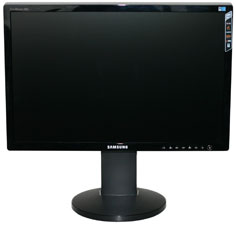 |
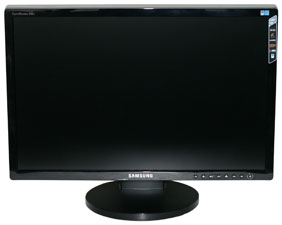 |
At the bottom right of the LCD, there are six buttons for accessing the on-screen display (OSD). Skipping the power button at the far right, which functions exactly as you would expect, the left button is a shortcut for enabling/disabling MPA. MPA stands for "Motion Picture Acceleration" and enabling it hopes to improve pixel response times. We'll find out later if it actually makes any noticeable difference in gaming as well. The second button brings up the main menu, and the next two buttons navigate through the menus. Pressing the menu button also exits out of submenus, while the fifth button (Source) acts as an enter button. When no other menus are active, the third button is a shortcut to cycle through the seven available color modes: Custom, Text, Internet, Game, Sports, Movie, and Dynamic CR. The fourth button also functions as a quick access to brightness levels, and the source button switches between available inputs -- note that if nothing is connected to an input, you can't switch to it without going through the full OSD menu. The Auto button is only useful in analog modes, where it will auto-adjust the screen size and centering, and the final PIP button turns on/off picture-in-picture.
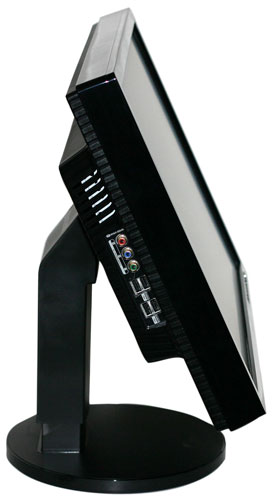 |
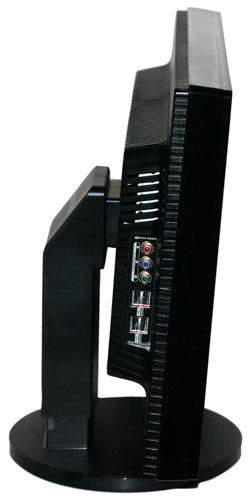 |
 |
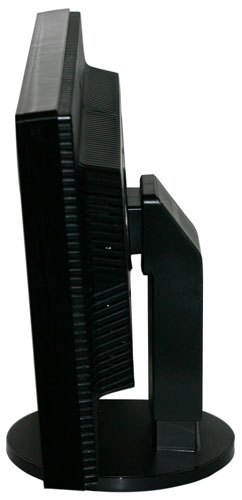 |
As mentioned earlier, the 245T supports the usual assortment of tilt, pivot, rotate, and height adjustment functions. You can see the range of motion available in the above images.
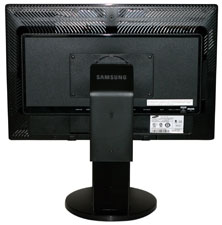 |
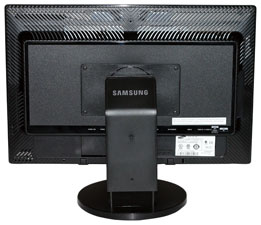 |
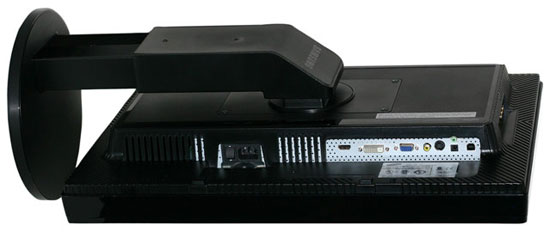 |
Most of the input ports all face downwards on the back of the display. The exception is the component input ports, which are on the left side of the display next to the four USB ports.
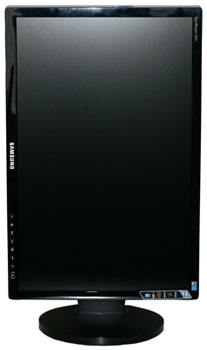 |
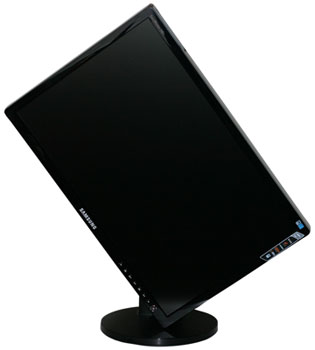 |
One nice feature of the stand is that it does allow you to raise the panel high enough that it can easily rotate into portrait mode. With some LCDs, we have found that you have to tilt the panel backwards as well as raising it to maximum height before you can rotate the display. If you find yourself frequently using portrait mode, the Samsung 245T would be a very good choice. Note also that the lack of cable management makes it easier to pivot the display.
We created a gallery showing all of the OSD menus and submenus, which you can access below. Most of the OSD functions are straightforward, but there are a few items worth pointing out.
First, there are multitudes of color adjustment options available. Not only can you adjust RGB levels, but you can also tweak hue and saturation via six color controls. We tend to find that amount of control more overwhelming than anything, but it's easy enough to ignore it and if you actually need such functionality it's there. Unfortunately, the second noteworthy item is a black mark; panel resolution scaling only offers two options: Wide or 4:3. "Wide" would be more appropriately named "stretch", as it will attempt to stretch any resolution to fill the entire screen -- without regards to aspect ratio. 4:3 on the other hand will fit any resolution into a 4:3 aspect ratio -- including 16:9 and 16:10 aspect ratios, even digital ones. What this all means is that sticklers who want 16:9 films not stretched vertically will be out of luck; similarly, people who connect an Xbox 360 or PS3 may be disappointed with the slightly stretched widescreen resolutions. What's missing from the scaling options are 1:1 (i.e. no stretch at all, giving black borders on all sides at lower resolutions) and proportional scaling (i.e. a 720p input would scale to fill 1920x1080, leaving black borders on the top and bottom edges) -- both of which are found on competing LCDs.
Update: The aspect ratio options are similar to what we found on the Samsung 2493HM when using the other input sources. In other words, 1:1 stretch is available on VGA connections. We no longer have the LCD, so we can't test the other inputs, but you can read the Samsung 2493HM review for more details.
















60 Comments
View All Comments
Owls - Thursday, February 7, 2008 - link
I agree. The ads are highly instrusive. Any other sites people recommend?GNStudios - Thursday, February 7, 2008 - link
I read the review and got very intrested in the monitor (I have a Samsung 215TW now). When browsing some the internet I found many people complaining that it's very noisy.Is this true?
mattsaccount - Thursday, February 7, 2008 - link
My parents bought one of these over Christmas. The monitor they received definitely emits a certain amount of noise, but none of us found it that distracting. You can barely hear it in normal use, and it's not an irritating high pitch ring or anything.JarredWalton - Thursday, February 7, 2008 - link
I haven't noticed any noise from this particular unit, but that's pretty variable. Usually the noise comes from capacitors inside the chassis, so as best as I can tell it's luck of the draw.kmmatney - Thursday, February 7, 2008 - link
I'd be interested to see how my $299 Soyo 24" LCD compares. It uses a non-TN panel (MVA), and can be had from OfficeMax.jimmy43 - Thursday, February 7, 2008 - link
Well I'm glad you guys talk about the different panel technologies to educate people, there is more than just the size and refresh time to a monitor. However, I'm wondering what is with the input lag taboo at these large sites? It's not too hard to measure, and it would complete your article so we dont have to go to independant reviewers to get a good idea of how laggy a monitor really is.nevbie - Thursday, February 7, 2008 - link
Agreed, and also, here is a reference to such a review that tests input lag (as an example): http://www.tftcentral.co.uk/reviews/content/hazro_...">http://www.tftcentral.co.uk/reviews/content/hazro_...Note that in many cases here the input lag exceeds the response time, that so many reviewers pay attention to.
Monitor reviews are very interesting, but so subjective..
Xbitlabs (www.xbitlabs.com) monitor reviews seem to have most of the measurements that I have seen in reviews, with the exemption of input lag.
PS. If you review HP LP2065 (I hear S-IPS or MVA), I'll give you a virtual hug. =P
tayhimself - Thursday, February 7, 2008 - link
Can the input lag be removed by disabling scaling etc? What causes input lag, and how is it measured? Thanks!JarredWalton - Thursday, February 7, 2008 - link
There are a few things to consider. First, how do you measure input lag? If you use two outputs on one GPU, they don't necessarily get identical content - you can get +/-1 frame difference due to refresh rates, internal buffering, etc. Using a splitter for a signal can do the same thing. So you have a margin of error of at least one frame. I've tested with varying techniques in the past and decided input lag wasn't a real issue... or at least not an issue you can easily fix just by changing LCDs. CRTs may be better in this area, but I'm even less willing to go back to using a cumbersome CRT.The real issues with image lag are more complex. You have things like double (or even triple) buffering that add one or two frames of lag. Then technologies like SLI and CrossFire add at least one frame of lag when doing AFR (the most common mode), and triple and quad solutions using AFR could add up to three frames of lag internally... and no one seems to worry about that. (I asked NVIDIA and ATI about this in the past, and their response was something along the lines of "you don't actually think anyone can notice the 0.02s delay, do you!?")
I tend to agree, at least for *most* people. Despite what many would like to think, our eyes really don't react quickly enough to notice differences of a couple hundredths of a second. If I ever encounter an LCD where I notice a problem with input lag, I'll make a note of it, but I haven't yet - even with the much-maligned 2407WFP.
I suppose professional gamers might have more issue with input lag, but then there are multiple sources of lag they need to try to reduce. There are lots of things that most people just live with and don't notice - image tearing because VSYNC is off, lag because you can't afford a $2000 CPU+GPU setup, lag at your input device (mouse/keyboard), running on a 19" LCD instead of 30".... Internal image lag in an LCD is one of these things in my book.
lyeoh - Tuesday, February 12, 2008 - link
Please do more useful reviews of monitors.Input lag is an issue with nonCRT monitors. In fact significant input lag is a _showstopper_ for many people (even if they didn't know of such a thing till they experienced it :) ).
I personally don't care about lags of 10-15ms but some LCD panels have been _tested_ and _documented_ by many to have lags of >50ms, and that is VERY SIGNIFICANT.
Go search youtube for input lag if you don't believe there are monitors with significant lag.
I have walked into a shop which was selling panel TVs and even the shopkeeper noticed the lag when I pointed it out, that screen had terrible lag (my guess is at least 100-200ms). Imagine playing Tekken on that and not seeing your opponent's move till 100ms after it has occurred...
Even a nonpro gamer playing Counterstrike or other FPS will find it annoying that he keeps getting shot by someone peeking round a wall/corner before he even gets to see that person. Games like Guild Wars allow some players to interrupt skills if you do things in time. Every millisecond counts. If your round trip ping is 100ms and your reflexes are 250ms, you can easily interrupt (with a 0.25 sec interrupt skill) opponent skills that take 0.75 seconds to cast (assuming the game adds 100ms max). If the panel is too slow, what used to be easy with a faster LCD/CRT becomes difficult if not impossible to do reliably.
Gamers might be able to tolerate colours not being so good, and even a few dead pixels (actually a dead pixel in the exact center makes it good for some games as a built-in crosshair ;) ), but high input lag badly affects the gaming experience far more.
As for the two outputs having a difference, just use a card which doesn't (you can check with CRTs). To be rigorous, you can always swap the outputs to confirm the results.
I'm sure you can think of ways of measuring input lag. Some people use a chronometer/stopwatch displaying on both the screen being tested and a CRT, and then take a few pictures of it with a decent camera.
The rest of your post about double/triple buffering etc is not relevant - little to do with a monitor review.
You can go measure system latency in a different review- PC, video card, game or even CPU review. It might be quite interesting, given a cache miss in modern CPUs can waste a lot of cycles. A CPU might perform well in throughput, but when there is an unexpected change it might take a while to reach top speed again. My guess is the time scales of a CPU make it unlikely that the latencies would reach the order of many milliseconds, but who knows...